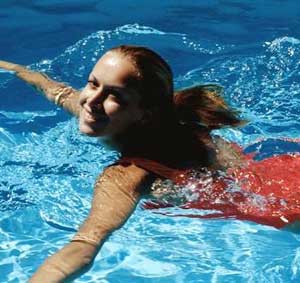To alleviate back pain, you cannot solely rely on medication; you must also combine it with exercise. Among various sports, swimming is the best option to help reduce your back pain.
Typically, when treating back pain, anti-inflammatory medications, pain relievers, and muscle relaxants are used. However, for individuals with stomach or duodenal issues, taking these medications can easily lead to complications such as gastrointestinal bleeding or perforation.
 |
| Swimming is the best sport to help reduce your back pain (Photo: cuc.edu) |
It is essential to combine medication with physical therapy and engage in suitable sports to achieve quicker results and minimize recurrence.
Physical Therapy for Back Pain
Implementing physical therapy for back pain is a practical approach but requires determination and persistence in following the guidance of healthcare professionals.
Exercise should be performed slowly and gently, avoiding any movements that cause pain. Correct techniques, combined with deep, rhythmic breathing, should be used while gradually increasing intensity to enhance spinal flexibility, strengthen back muscles and ligaments, and create balance in spinal postures, ultimately reducing pain.
In the initial phase, pain relievers may be used, but eventually, medication should be discontinued in favor of exercise and massage.
At first, focus on stretching exercises to increase spinal joint flexibility; once pain diminishes or disappears, shift to strengthening exercises for the muscles and ligaments in the back.
Sports for Back Pain Relief
After a period of regular therapeutic exercises, if health improves and back pain symptoms significantly diminish, swimming, brisk walking, or alternating brisk walking with small running steps can be incorporated. Among these, swimming is the most suitable method as brisk walking or small running can increase stress on the joints and potentially worsen spinal conditions.
Why is Swimming Beneficial for Those with Back Pain? In water, the effects of gravity are reduced. When swimming, the joints in the legs and spine experience minimal load from body weight. Cardiovascular and respiratory functions are strengthened, enhancing overall endurance without straining the joints. Moreover, swimming helps strengthen back muscles, better nourish joints, and can slow the degenerative process in the joints, reducing the frequency of pain recurrence.
Due to the unique properties of water, the strain on the circulatory system during swimming is lower compared to running. Therefore, to achieve health benefits from swimming, one should gradually increase swimming speed to reach a heart rate of 125-130 beats per minute. The inhalation and exhalation actions during swimming are challenging due to water pressure on the swimmer’s chest, making swimming an excellent way to develop the respiratory system and increase lung capacity.
Obesity is also a contributing factor to lower back pain and joint pain in the legs, as excess body fat adds extra weight to the muscles and joints, particularly in the knees, hips, and lower back. Swimming burns approximately four times more calories than walking at the same pace, making it an excellent method for reducing excess body weight. Additionally, the cold water environment enhances the body’s resilience against environmental stressors (heat, cold, etc.) due to acclimatization.
When water interacts with skin receptors, it increases the activity of bioelectric currents, stimulating nerve cells, balancing excitation and inhibition processes in the cerebral cortex, and quickly alleviating fatigue resulting from mental stress.
For swimming to be effective in treating health issues and improving well-being, it is essential to swim three times a week (on alternate days), gradually increasing the duration of each session to 25-30 minutes. Consistent and continuous training is crucial. Gradually increase swimming speed during sessions to maintain a heart rate of 125-130 beats per minute while swimming.


















































